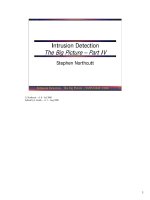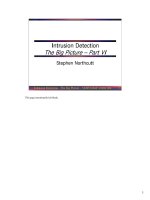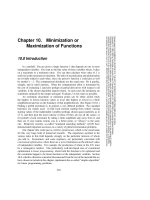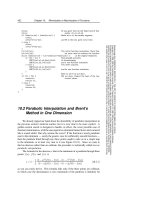Tài liệu CIS 185 CCNP ROUTE EIGRP Part 1 pdf
Bạn đang xem bản rút gọn của tài liệu. Xem và tải ngay bản đầy đủ của tài liệu tại đây (2.51 MB, 113 trang )
CIS 185 CCNP ROUTE
EIGRP Part 1
Rick Graziani
Cabrillo College
Last Updated: Fall 2012
2
EIGRP Part 1
Review
Neighbor Adjacencies and
EIGRP Reliability
EIGRP Metric
DUAL
Basic EIGRP Configuration
Passive-Interfaces
Summarization
Default Route
3
Materials
Book:
Implementing Cisco IP Routing
(ROUTE) Foundation Learning
Guide: Foundation learning for the
ROUTE 642-902 Exam
By Diane Teare
Book
ISBN-10: 1-58705-882-0
ISBN-13: 978-1-58705-882-0
eBook
ISBN-10: 0-13-255033-4
ISBN-13: 978-0-13-255033-8
Review
5
What do we remember about EIGRP?
What type of protocol is EIGRP?
Distance Vector
What are the default metrics used by
EIGRP?
Bandwidth (slowest) and Delay (cumulative)
What are the optional metrics?
Reliability and Load
Note: Book also state MTU but it is not a metric.
What algorithm is used to determine best
path?
DUAL (Diffusing Update Algorithm)
6
Review of EIGRP from CCNA
Enhanced Interior Gateway Routing Protocol (EIGRP)
Released in 1992 with Cisco IOS Software Release 9.21.
Enhancement of Cisco’s:
Interior Gateway Routing Protocol (IGRP).
Both are Cisco proprietary, operate only on:
Cisco routers
7
RTP and EIGRP
Packet Types
What transport layer protocol does EIGRP use?
Reliable Transport Protocol (RTP)
Why doesn’t EIGRP use UDP or TCP?
8
Protocol-
Dependent
Modules
EIGRP uses protocol-dependent modules (PDM). to route
different protocols, including:
IPv4
IPv6
Internetwork Packet Exchange (IPX)
AppleTalk
EIGRP Packet
Frame Header
Frame Payload
CRC
IP
Header
Protocol Number
(EIGRP = 88)
EIGRP
Header
EIGRP
Message
On a LAN, the EIGRP
packet is encapsulated
in an Ethernet frame
with a destination
multicast MAC address:
01-00-5E-00-00-0A
The destination IP address is
set to the multicast 224.0.0.10
and the EIGRP protocol field
is 88.
The EIGRP
header identifies
the type of EIGRP
packet and
autonomous
system number.
The EIGRP
message
consists of
the Type /
Length /
Value (TLV).
EIGRP Header
EIGRP Packet
12
EIGRP Packet
Types – Hello
Packet
What are Hello packets used for by EIGRP to:
Discover neighbors (sometimes called neighbo rships)
Form adjacencies with those neighbors
What is the multicast address? Hint: 224.0.0.?
224.0.0.10
Are these sent as reliable or unreliable deliver?
Unreliable delivery – No ACKs returned
13
Hello Protocol
NBMA Link that are
All other serial interfaces and
LANs
14
Hello Protocol
Default hold time - 3 times the hello interval
If the hold time expires:
EIGRP declares the route as down
DUAL searches for a new path in the topology table or by
sending out queries.
It is NOT automatically adjusted if Hello Interval is modified.
NBMA Link that are
All other serial interfaces and
LANs
15
Update Packets – Reliable Delivery
Acknowledgment (ACK) Packets – Unreliable Delivery
Sent when reliable delivery is used (update, query, and reply
packets).
EIGRP uses
triggered
updates
EIGRP Packet Types –
Update and
Acknowledgement
Packets
16
EIGRP Packet
Types – Query
and Reply
Packets
Queries and replies use reliable delivery (Ack
returned).
Used by DUAL when searching for networks and other
tasks.
17
DUAL: An Introduction
J. J. Garcia-Luna-Aceves
18
DUAL: An Introduction (More later!)
.
X
Or holdtime expires
R2: Checks
Topology table for
Feasible
Successor. If no
FS…
19
Summary - RTP Packet Types
Hellos – Identifies neighbors
Used by the neighbor discovery and recovery process.
Multicast
Unreliable delivery
Acknowledgements (ACK) – Acknowledges receipt
Hello packets with no data
Unicast
Unreliable delivery
Updates – Advertises routes
Transmitted only when necessary
Unicast when sent to a specific router
Multicast when sent to multiple routers
Reliable delivery
Queries – Ask about a route (DUAL)
Reliable delivery
Multicast or Unicast
Queries and Replies – Ask about a route and answer a
query (DUAL)
Reliable delivery
Replies: Unicast
20
Administrative Distance
We will discuss Administrative Distance in more detail in a later
chapter.
Later in this chapter, you learn how to configure EIGRP summary
routes.
Routes manually
summarized.
Routes redistributed into
EIGRP.
Neighbor Adjacencies and
EIGRP Reliability
21
22
Configuring Hello Intervals and Hold Times
Configurable on a per-interface basis, NOT per neighbor
(LANs)
Does not have to match with other EIGRP routers to
establish adjacencies.
Router(config-if)# ip hello-interval eigrp as-number seconds
Router(config-if)# ip hold-time eigrp as-number seconds
Neighbor Table Contents
23
R1# show ip eigrp neighbors
IP-EIGRP neighbors for process 100
H Address Interface Hold Uptime SRTT RTO Q Seq
(sec) (ms) Cnt Num
0 192.168.1.102 Se0/0/1 11 00:07:22 10 2280 0 5
R1#
Lists the order in
which a peering
session was
established with
the specified
neighbor, starting
with 0.
Neighbor’s
IP address
Local interface
receiving EIGRP
Hello packets.
Seconds remaining before declaring neighbor
down.
The current hold time and is reset to the
maximum hold time whenever a Hello packet
is received.
SRTT (Smooth Round Trip Timer) and RTO (Retransmit Interval) are used by
RTP to manage reliable EIGRP packets.
SRTT indicates how long it takes for this neighbor to respond to reliable
packets.
RTO indicates how long to wait before retransmitting if no ACK is received.
Queue count
should always be
zero otherwise
there’s
congestion on the
link.
The sequence
number of the
last update,
query, or reply
packet that was
received from
this neighbor.
Amount of time
since this
neighbor was
added to the
neighbor table.
Neighbor Table Contents
Smooth Round Trip Timer (SRTT)—The
average number of milliseconds it takes
for an EIGRP packet to be sent to this
neighbor and for the local router to
receive an acknowledgment of that
packet.
Used to determine the retransmit interval, a.k.a.
retransmit timeout (RTO).
RTO—The amount of time, in
milliseconds, that the router waits for
an acknowledgment before retransmitting
a reliable packet from the
retransmission queue to a neighbor.
24
Start
Stop
Start
Stop
No ACK Returned
EIGRP Reliability
RTO—The amount of time, in milliseconds, that
the router waits for an acknowledgment before
retransmitting a reliable packet from the
retransmission queue to a neighbor.
Updates, queries and replies are sent
reliably.
A sequence number is assigned and an explicit
ACK is returned for each sequence number.
25
Start
Stop
No ACK Returned
If the RTO expires before and ACK is received, EIGRP retransmits another copy of
the packet.
A maximum of 16 times OR until the hold time expires then the Neighbor is
declared down.
When a neighbor is declared down:
The adjacency is removed
All networks reached through that neighbor are removed from the routing
table.
180 second hold time on low-speed NBMA links can be a long time to wait.
Retransmission occurs after each RTO timer expires.
After 16 attempts the neighbor is declared down.
This is less time than waiting for the hold time to expire.
16 x RTO < Hold Timer









